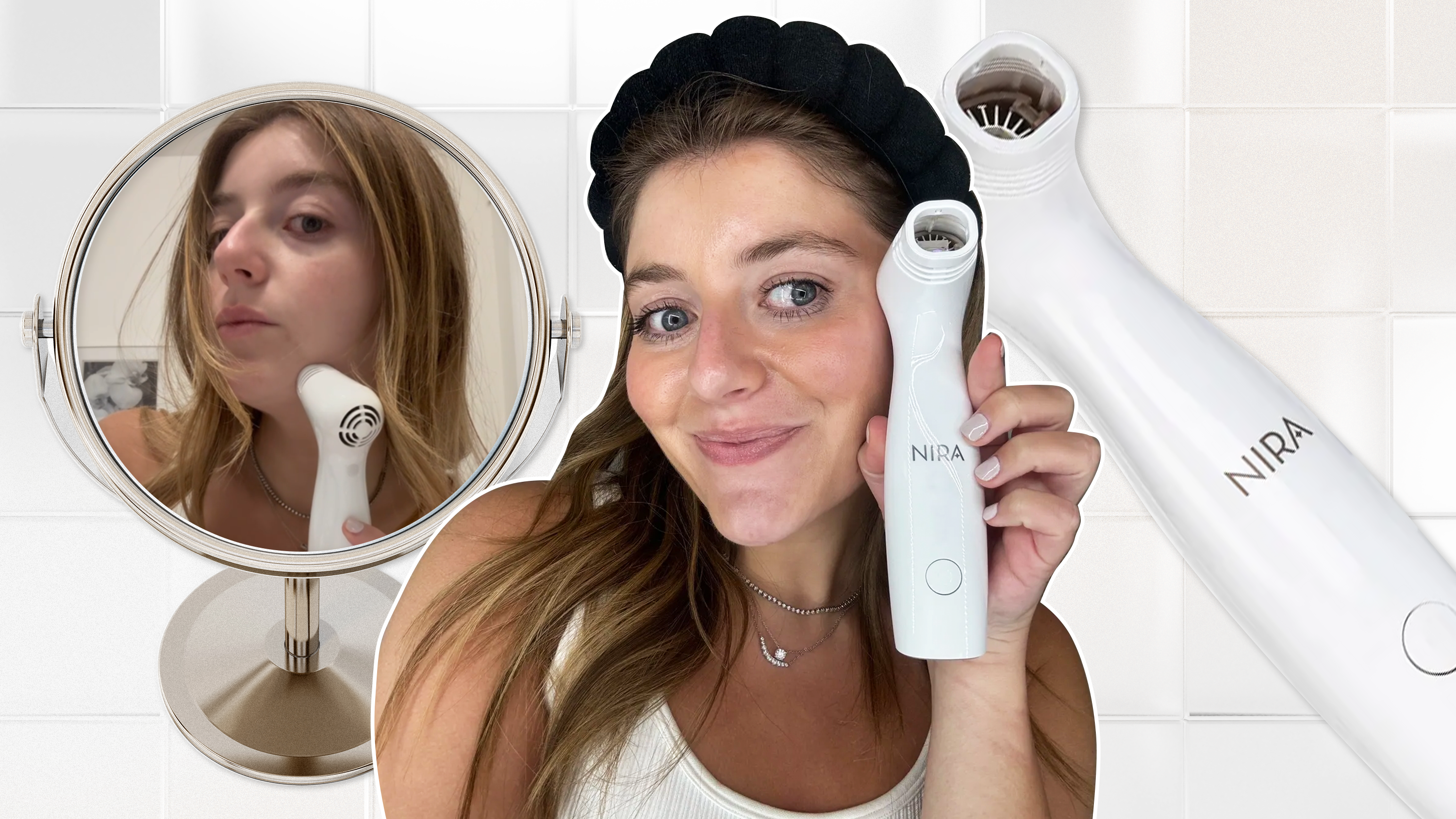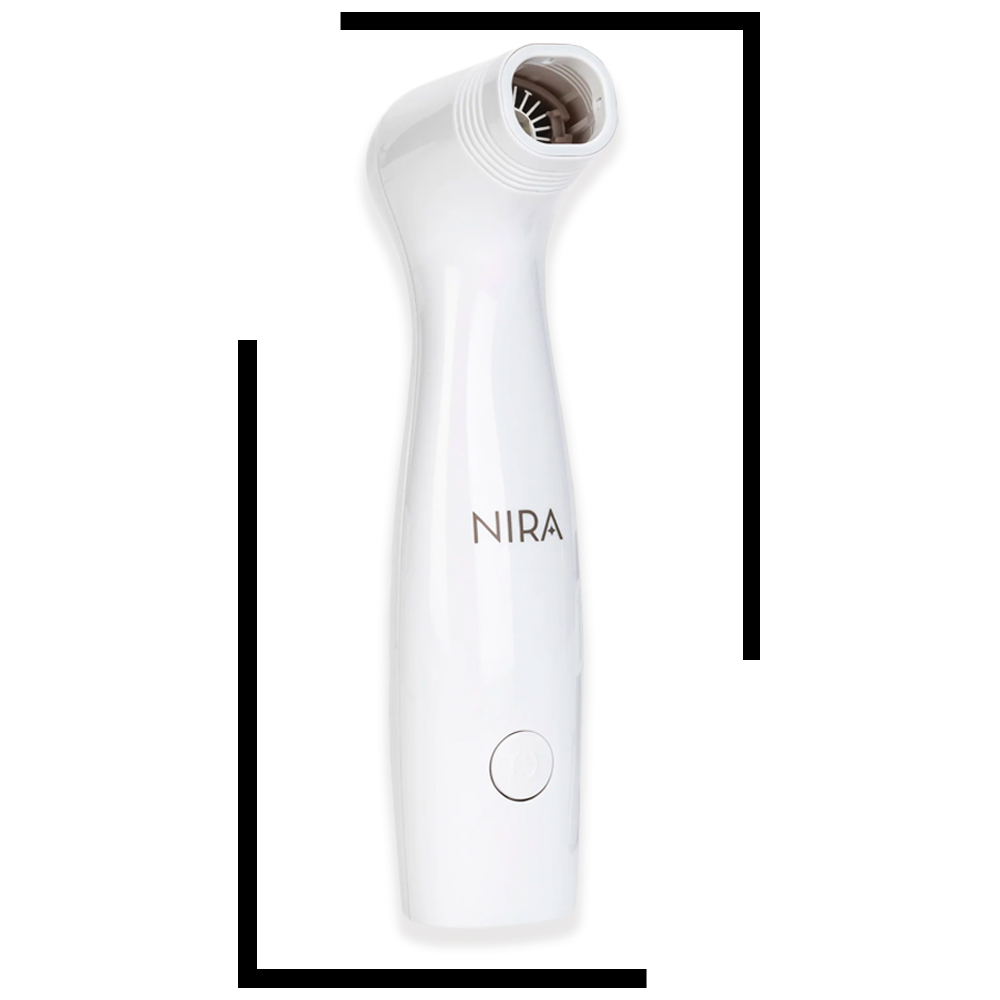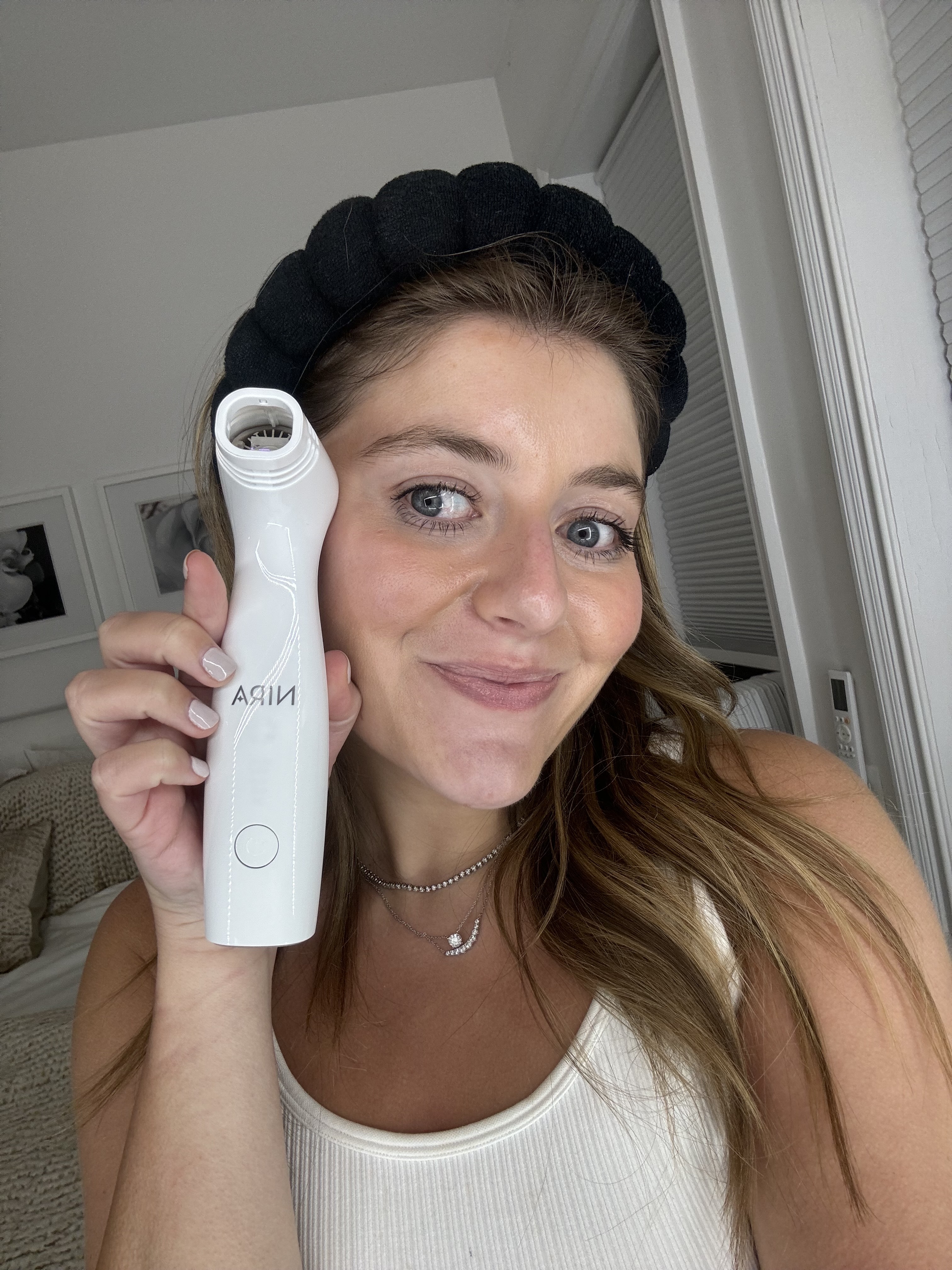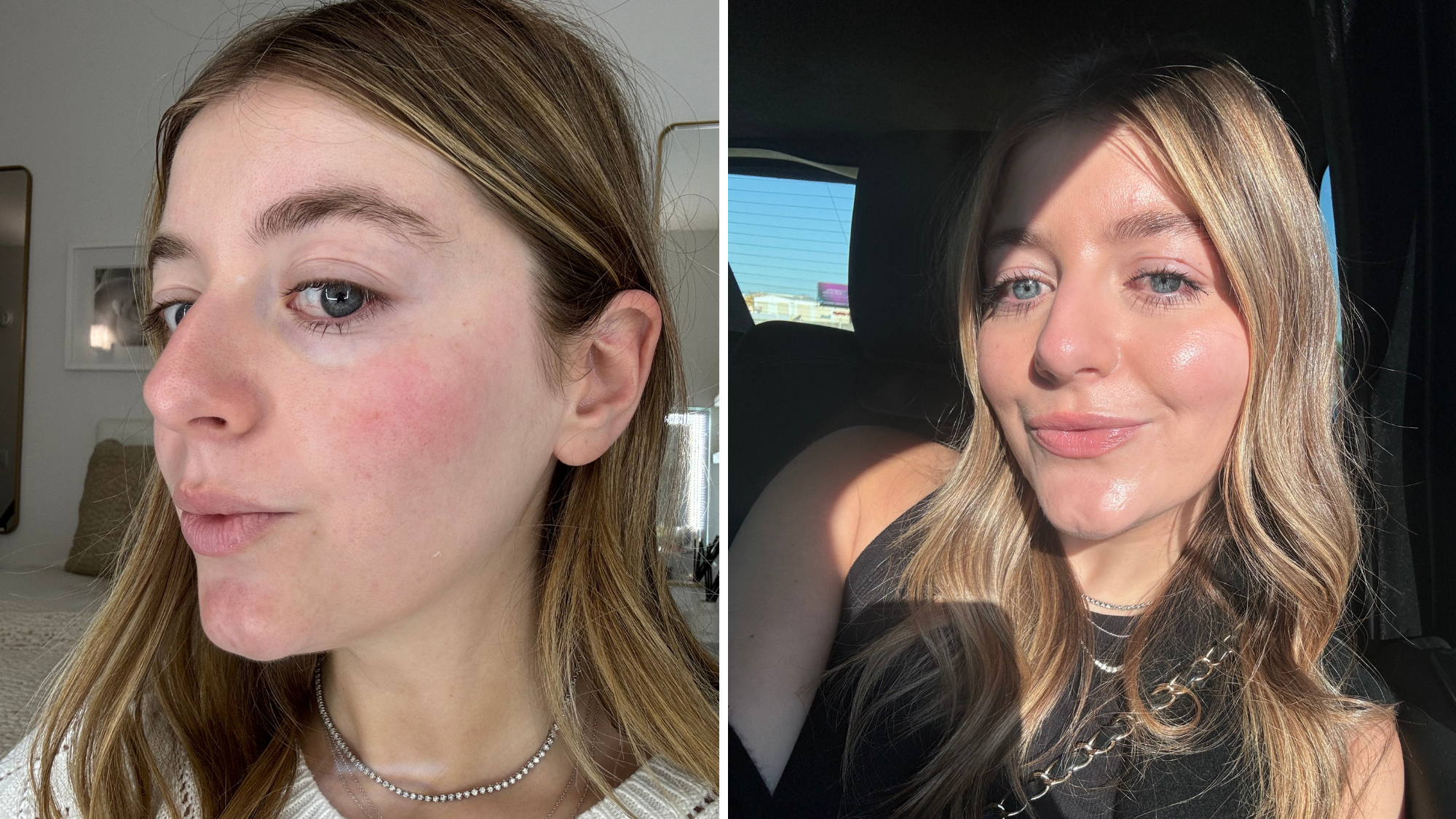This $599 At-Home Laser Helped My Skin Glow More Than Any In-Office Treatment
I have the photos to prove it.


- What Is the Nira Pro Laser?
- Does the Nira Pro Laser Really Work?
- How Does the Nira Pro Laser Work?
- What Are the Benefits of the Nira Pro Laser?
- Who Should Use the Nira Pro Laser?
- Are There Any Risks With the Nira Pro Laser?
- How to Use the Nira Pro Laser
- What's the Difference Between the Nira Pro Laser and the Lyma Laser?
- How Is the Nira Pro Laser Different From At-Home LED Treatments?
- How Does the Nira Pro Laser Compare to In-Office Treatments?
- My Review of the Nira Pro Laser
I’m a wannabe cosmetic dermatologist. While I can’t safely pump my own face with fresh Botox or operate a Sofwave machine to tighten my arms (le sigh), I can put every at-home gadget to the test. I’ve tried, well, pretty much everything: the best LED masks, microcurrent devices, the Foreo, laser hair removal tools, and microneedling, to name a few. But the latest innovation to come across my desk—the Nira Pro Laser—might just be my favorite.
Here’s the deal: It’s a non-ablative laser, which essentially means it gives cells a kick in the butt to produce more collagen without causing damage to the outer layer of the skin or causing discomfort. Despite having “Pro” in the name, it’s safe enough to be used by untrained hands (hi, yes, me). Think of it like a fine-line-reducing, skin tone-evening baby sister to intense in-office treatments like Fraxel or CoolTouch.
The results aren’t said to be as intense or automatic as an in-office treatment, but they can offer skin-plumping and smoothing results over time. At-home laser devices aren’t mainstream—there’s only one other device to compare to Nira.
I like to know everything when using something on my face, so I spoke with board-certified dermatologists Robert Finney, MD FAAD, Amanda Doyle, MD FAAD, and Mara Weinstein Velez, MD FAAD, to learn more about the device's technology, safety, and limitations. Then, I put the Nira Pro Laser to the test for two months—and, well, I’ll let my before-and-after photos speak for themselves.

This three-to-five-minute daily treatment leverages laser technology to rebuild collagen, plump fine lines, and reduce wrinkles in a painless and safe manner. The brand even promises visible results within 90 days.
FDA-approved: Yes
What’s Included: Nira Pro Laser, charging cable, three-month supply of Nira Moisture Lock Hyaluronic Acid Serum and Youth Renewal Moisture Cream
How It Works: Uses heat shock protein to warm the dermis (lower layer of the skin) just enough so that it doesn’t cause pain or redness, while still stimulating collagen production
What We Love: Safe and put through rigorous testing, the brand opted to conduct clinical trails to prove efficacy; compact and great for on-the-go treatments; it's thought to improve skin tone and reduce acne scars
What We Don’t: Not nearly as powerful as in-office treatments; expensive; some dermatologists are very skeptical that it even offers any benefits
What Is the Nira Pro Laser?
The Nira Pro Laser is a non-ablative, non-fractional laser that targets the full face, neck, chest, and back of the hands. In other words: “It heats the deeper part of the skin, called the dermis, to a level that activates heat shock protein,” explains Dr. Doyle. “This helps certain types of collagen mature and develop, but does not cause pain.”
Does the Nira Pro Laser Really Work?
Yes, the Nira Pro Laser does really work, but you need to manage your expectations. You must use the tool daily and give it 90 days to show results.
How Does the Nira Pro Laser Work?
Just like the skin lasers you’ll find in your dermatologist's office, the Nira Pro Laser is a diode laser. What does this mean, you ask? This means a single light wavelength is emitted, and energy is converted into heat. “This over-the-counter, non-fractional diode laser device employs 1450 nm wavelength, making its target predominantly water,” explains Dr. Doyle. While the wavelength is pretty similar to what you find in office, it’s delivered with much lower energy.
Get exclusive access to fashion and beauty trends, hot-off-the-press celebrity news, and more.

The Nira Pro laser is pretty compact and great for travel.
The Nira will essentially heat up water, but unlike an ablative laser, it won’t cause it to evaporate. “The top surface of the skin stays relatively unscathed, while the heated water ideally creates a cascade that leads to collagen induction and skin improvement,” explains Dr. Finney. In turn, your skin will look and feel entirely the same before and after the treatment—you shouldn’t experience any visible redness or irritation.
What Are the Benefits of the Nira Pro Laser?
From a practical standpoint, the Nira Pro Laser is pretty game-changing. “It was previously only available as an in-office treatment, so to have access to this technology in an at-home device is novel,” says Dr. Doyle. “You can use it on your own schedule and in the privacy of your own home.”
As for the efficacy? The brand promises that it’s clinically proven to stimulate collagen and produce younger, firmer-looking skin in 90 days. “It has also been shown to tighten skin, even skin tone, lift hooded eyes, brighten dark spots, and improve acne scarring,” the brand’s website reads.
Dr. Finney adds that with regular use, you are likely to stimulate some collagen production over many months—but doesn’t want patients to expect the Nira to compete with in-office lasers like Fraxel. Because—spoiler alert—it won’t. “You’ll likely see a little improvement with a glow and shrunken pores,” he says. “You may also feel a little bit of skin tightening.”
Who Should Use the Nira Pro Laser?
The Nira Pro Laser has been tested and FDA-approved for use on all skin tones. It’s a great option for those who aren’t quite ready to get a stronger, in-office treatment or for people who want to maintain their in-office results at home.

The Nira has given my skin a post-facial like glow every day.
With that in mind, Dr. Doyle says to use extra caution if you have heat-sensitive skin conditions (think: rosacea or melasma) or have had active or recent sun exposure or burns.
Are There Any Risks With the Nira Pro Laser?
There are risks with any at-home device, but the Nira Pro Laser is pretty safe. “The energy that they're delivering is gonna be subtherapeutic, which is why it's safe in anybody’s hands,” explains Dr. Finney. Because the wavelength is delivered at such a low energy, you’re A-ok with using it on all skin tones. Those with darker skin tones can use the device, but it’s better to stick to the lower settings to avoid unwanted pigmentation.
Just be careful when using the precision tip around the eye area, and don’t stare into the laser. “It can cause eye damage and vision loss,” adds Dr. Finney.
How to Use the Nira Pro Laser
Good news: You won’t need conductor gels or special serums. Just a freshly washed face will do the job. Then, turn on your Nira Pro by pressing the power button. Work it around your face for three to five minutes daily; it will shut off automatically after your treatment.
But as always, make sure to consult with your dermatologist before integrating an at-home device into your routine. “Too much of a good thing is never a good thing. You can overdo it,” says Dr. Doyle. “I strongly suggest you get a dermatologist’s input on your skin type and a good skincare routine first, followed by considering slowly adding adjuncts like this as it makes sense.”
What's the Difference Between the Nira Pro Laser and the Lyma Laser?
The Nira Pro and the Lyma Laser are two of the most potent at-home devices on the market. While they're typically lumped together in the at-home device discussion, they're very different. From a tech standpoint, Lyma laser combines LED and low-level laser therapy, while the Nira Pro uses non-fractional laser therapy. That means that while the Lyma is a "cold laser" that diffuses light wavelengths evenly through the skin to improve hyperpigmentation and redness, the Nira Pro uses a heat energy that can feel a bit toasty. "The Lyma might help with redness and inflammation because of that low-level laser light therapy, whereas the Nira Pro is trying to compete with the Fraxels of the world and induce collagen production," explains Dr. Finney.
Another key difference is the time it takes to see results. The Nira requires roughly three to five-minute treatments, with results visible in around three months, whereas the Lyma requires 15-minute daily treatments, with results visible around the three to six-month mark.
Finally, the two devices differ in price. The Lyma is also roughly triple the price of the Nira Pro Laser, with a price tag of $2,695.
How Is the Nira Pro Laser Different From At-Home LED Treatments?
Honestly: "There are no clinical studies showing data comparing the two devices," says Mara Weinstein Velez, MD FAAD and board-certified dermatologist. "Knowing that each LED mask varies greatly in terms of the number of bulbs, types of lights, treatment protocols, and suggestions, it's difficult to make a comparison."
That said, LED masks can be more user-friendly than the Nira Pro, as "there is nothing required from you in terms of treating in a certain pattern or with a certain number of passes." Contrastingly, the Nira Pro offers targeted treatment that most LED masks do not.
Both high-quality LED masks and the Nira Pro are proven to stimulate low-level collagen production and reduce wrinkles. However, the Nira Pro targets deeper layers of the skin, while most at-home masks are superficial.
How Does the Nira Pro Laser Compare to In-Office Treatments?
For most people, the Nira Pro Laser isn't going to replace in-office treatments—it's additive and can be used in between dermatologist appointments. The Nira is less energy and slower to work than its in-office counterparts. "The Nira pro is a very low energy, low-level diode laser that is meant to be used daily or even twice daily at home for at least 90 days to achieve the results of collagen stimulation, wrinkle reduction, and overall skin brightening," explains Dr. Velez. "In the office laser treatments are typically performed monthly for a few months."
It's also worth noting that we don't know how long the results from the Nira Pro last. "Depending on your individual goals, an in-office treatment like the Clear and Brilliant might make more sense since it requires less time daily and also produces similar results after one treatment," says Dr. Velez.
My Review of the Nira Pro Laser
About My Skin:
I’m going to be incredibly honest here. I’m in my late 20s, and thanks to religious retinol use, a strong skincare routine, and genetics, I haven’t noticed any fine lines or wrinkles—yet. Still, that doesn’t mean I’m without skin concerns. Due to some acne flares and perioral dermatitis (and an acne-looking rash around my mouth), I have some dark spots. And I’ll never object to a product that can boost my glow.
With that in mind, my skin is incredibly sensitive and prone to inflammation, so despite the promise that this device was pain—and redness-free, I still found myself a bit concerned.
How I Used It:
As I said, I’m going to be honest. And honestly, I was pretty confused. I wasn’t entirely sure how I was supposed to use the device and found myself down a YouTube spiral. Fast-forward through the learning curve, and I powered on the tool, testing it on my skin to see how much heat I could tolerate. I settled on level three (there are five settings), which felt very warm without being too hot on my skin.
I listened to the beeping (the device sounds once when it hits the skin and once when the area has been treated) and then established my treatment pattern around my face. I pressed the Nira Pro along my eye contour, cheeks, forehead, and chin, repositioning the device with every “beep.” (FYI: There’s a built-in fan in the device that makes a decent amount of noise. It’s not going to combust spontaneously—it’s normal.)
I repeated the pattern until the device automatically turned off. It took no more than two minutes and my extremely sensitive, heat-averse skin came out unscathed.
It technically takes 90 days or three months to see results. Currently, I'm around two months into testing. I've done my best to remember to test every day, but candidly, I've definitely forgotten a handful of times.
My Results:
I’ve tried in-office non-ablative lasers which are more powerful than the Nira, so I knew any improvement to my tone and tightness would be relative—and take time. Patience is a virtue and one that I really had to exercise during the testing process.
I was hoping for an improvement in my skin tone, a little extra glow, and a fading of some hyperpigmentation around my mouth. At first, I noticed literally no changes. I felt nothing during the treatment and saw not even a bit of a difference after my treatment. But right around the two-week mark, I began to see that my skin had a brightness that can only be described as a post-facial glow. It adopted an almost reflective quality that I’ve never been able to achieve from skincare alone.

On the left is Samantha before testing the NIRA Pro Laser. On the right is Samantha approximately two months into testing the NIRA Pro Laser.
Was my neck lifted? Not necessarily. Did I have fine lines to plump? Nothing there. But the more time that went on, the bigger the difference I saw. By 60 days (I definitely missed a few treatments, FYI), I was starting to notice a more even tone, less redness, and a lightening effect on pesky dark spots that had been lingering around my mouth.
All in all, I’m impressed. It’s certainly not replacing my need for a heavy-duty laser or my dermatologist, but the Nira Pro did genuinely brighten my complexion, even out my tone, and provide an insane glow.
Why Trust Us
Beauty Editor Samantha Holender has nearly a decade of experience in the beauty industry and has tested dozens of at-home devices, including the Foreo, TheraFace, NuFace, and a handful of the best at-home LED masks. She also spent two months testing the Nira Pro, tracking her progress weekly, and consulting with three different board-certified dermatologists to fully understand how the energy-based device works.
Meet the Dermatologists

Robert Finney, M.D., a Board-Certified Dermatologist, Fellowship-Trained in Hair Restoration and Aesthetics. Originally from Pittsburgh, PA, Dr. Finney completed his undergraduate and medical degrees at Pennsylvania State University. He completed his internship and dermatology residency at Thomas Jefferson University Hospital in Philadelphia, PA where he served as chief resident during his final year. Following his residency, he completed an advanced fellowship in aesthetics, hair restoration, and skin surgery with renowned hair surgeon Dr. Marc Avram in New York City.Dr. Finney approaches aesthetics holistically, taking into account not only patients' current concerns, but also planning for the future. He takes pride in establishing longitudinal relationships, educating his patients on the 3D-nature of aging, and ultimately ensuring a future of aging gracefully. His goal is to ensure that his patients look refreshed, never “done”.As a hair expert, Dr. Finney continues to push the standard of care, and innovates to create cutting edge, individualized treatment plans. He has been treating his own genetic hair loss since his mid-20s; therefore, he is truly able to view each treatment through the lens of the patient and provider. This is what led him to create his ScalpStim Pro treatments: efficacious, customized treatments for his patients.Dr. Finney has authored several peer-reviewed articles and book chapters on hair loss. He frequently lectures both nationally and internationally on the topic, leading him to be sought after by major media outlets to share his expertise re: skin and hair. Dr. Finney takes pride in helping mold the next generation of dermatologists, acting as clinical assistant professor at Mount Sinai - Icahn School of Medicine. When not seeing patients, Dr. Finney loves reading historical non-fiction, and staying active playing ice hockey, hiking or competing on peloton.

Amanda Doyle, M.D., FAAD, is a Board Certified Dermatologist, Fellow of the American Academy of Dermatology and active member of The Women’s Dermatologic Society.
Dr. Doyle has received numerous honors and awards for her clinical excellence and research contributions to the field of dermatology. Having worked together with Dr. Russak at Russak Dermatology Clinic for the past several years, they share the same philosophy of providing top-level care to patients, bringing you only the very best in both medical and aesthetic dermatology.
Dr. Doyle serves as faculty at Mount Sinai Hospital, where she teaches dermatology residents and medical students. She graduated summa cum laude from the University of Rochester and completed her dermatology residency at SUNY Downstate Medical Center, where she scored in the top 98th percentile, amongst the highest in the country, on the National Board Exam. During her time there, she was awarded the William Montagna Award for Excellence in Dermatological Research for her novel work on acne while working under the mentorship of acne expert, Dr. Alan Shalita. Dr. Doyle’s research on acne and aesthetic medicine has been presented in several conferences across the country.
Dr. Doyle specializes in overall facial and skin rejuvenation, and provides personalized, refreshed, natural results. Her multi-modality approach often entails in-office procedures in combination with at-home skin care. Having studied art and design in Paris, Dr. Doyle hails from a unique background in her aesthetic work, incorporating injectables such as fillers and neuromodulators such as Botox® and Dysport®, laser treatments, micro needling, platelet rich plasma therapy and skin tightening/contouring devices to help patients achieve their goals.
In addition to her mastery of skin rejuvenation, Dr. Doyle has excellent bedside manner and genuinely cares for her patients, being one of the top-rated doctors on Charlotte’s Book and ZocDoc. Dr. Doyle often serves as a consultant for media outlets such as New York Magazine, Health, Shape, and Self magazines and she is frequently called upon by top aesthetic companies for her expertise. Dr. Doyle has been chosen to teach her injectable and skin tightening/contouring techniques to other physicians across the country. She serves as a principal investigator for ongoing studies with Ultherapy®, the only FDA-cleared, non-invasive procedure that lifts and tightens the skin. Dr. Doyle continually strives to advance her techniques to provide her patients with the highest level of care.

Mara C. Weinstein Velez, M.D., FAAD is a board-certified dermatologist who completed a prestigious Laser, Cosmetic and Dermatologic Surgery fellowship at SkinCare Physicians in Boston, with clinical faculty from the Harvard and Yale Departments of Dermatology. She is thrilled to be part of the Dermatology Department at the University of Rochester Medical Center and to serve as one of the only Fellowship-trained Cosmetic and Laser Surgeons in Western NY.She earned her bachelor's degree from Princeton University and completed her Dermatology residency training at the world-renowned Cleveland Clinic in Cleveland, OH. Dr. Weinstein has been invited to present at national professional meetings, published numerous articles in peer-reviewed journals and co-authored chapters in dermatologic textbooks including Surgery of the Skin, Treatment of Traumatic and Burn Scars and Procedures in Cosmetic Dermatology. She has been working in clinical research for over 4 years as both a sub-investigator and principal investigator and has participated in over 15 clinical research trials for state-of-the-art laser devices, minimally invasive cosmetic treatments and new acne medications.Dr. Weinstein has received numerous awards and achievements, including the Excellence in Teaching Award, Cleveland Clinic Foundation, the Women's Dermatology Society (WDS) Mentorship Award, and was most recently selected to be a part of the American Society for Dermatologic Surgery (ASDS) Future Leaders Network. She serves on the Board of Directors for the WDS and holds positions on Diversity, Networking, Fundraising and educational committees for national societies. Outside of work hours, Dr. Weinstein enjoys spending time with her husband and 3 children, exercising and traveling.

Samantha Holender is the Senior Beauty Editor at Marie Claire, where she reports on the best new launches, dives into the science behind skincare, and shares the breakdown on the latest and greatest trends in the beauty space. She's studied up on every ingredient you'll find on INCI list and is constantly in search of the world's glowiest makeup products. She's constantly tracking the biggest nail and hair trends to pop up in the beauty space, going backstage during fashion weeks, tracking celebrity looks, and constantly talking to celebrity hair stylists, nail artists, and makeup artists. Prior to joining the team, she worked as Us Weekly’s Beauty and Style Editor, where she stayed on the pulse of pop culture and broke down celebrity beauty routines, hair transformations, and red carpet looks. Her words have also appeared on Popsugar, Makeup.com, Skincare.com, Delish.com, and Philadelphia Wedding. Samantha also serves as a board member for the American Society of Magazine Editors (ASME). She first joined the organization in 2018, when she worked as an editorial intern at Food Network Magazine and Pioneer Woman Magazine. Samantha has a degree in Journalism and Mass Communications from The George Washington University’s School of Media and Public Affairs. While at GWU, she was a founding member of the school’s HerCampus chapter and served as its President for four years. When she’s not deep in the beauty closet or swatching eyeshadows, you can find her obsessing over Real Housewives and all things Bravo. Keep up with her on Instagram @samholender.